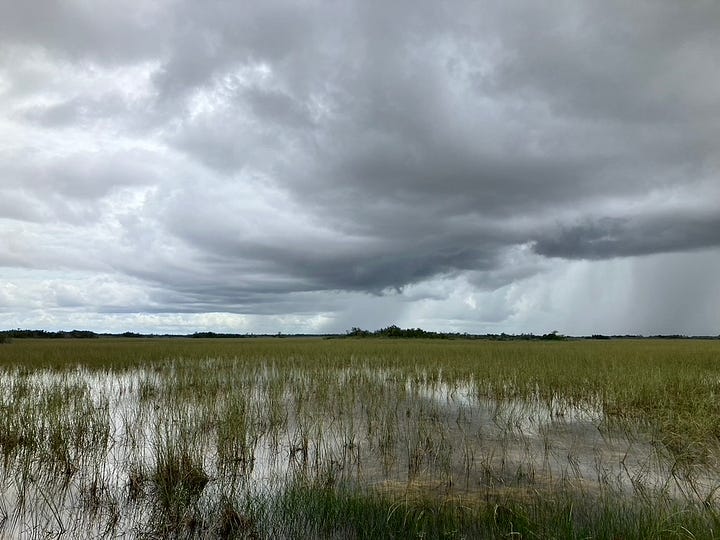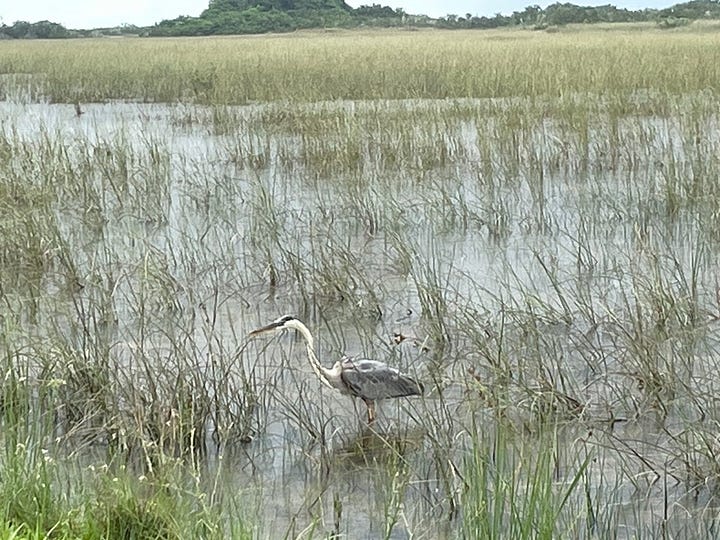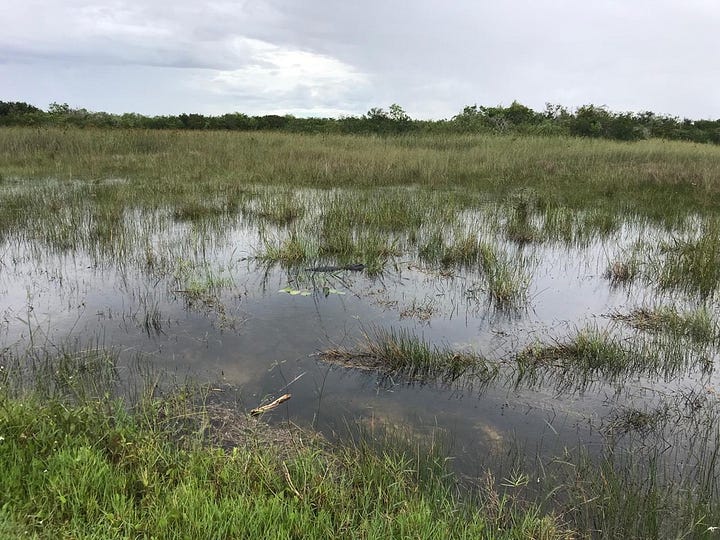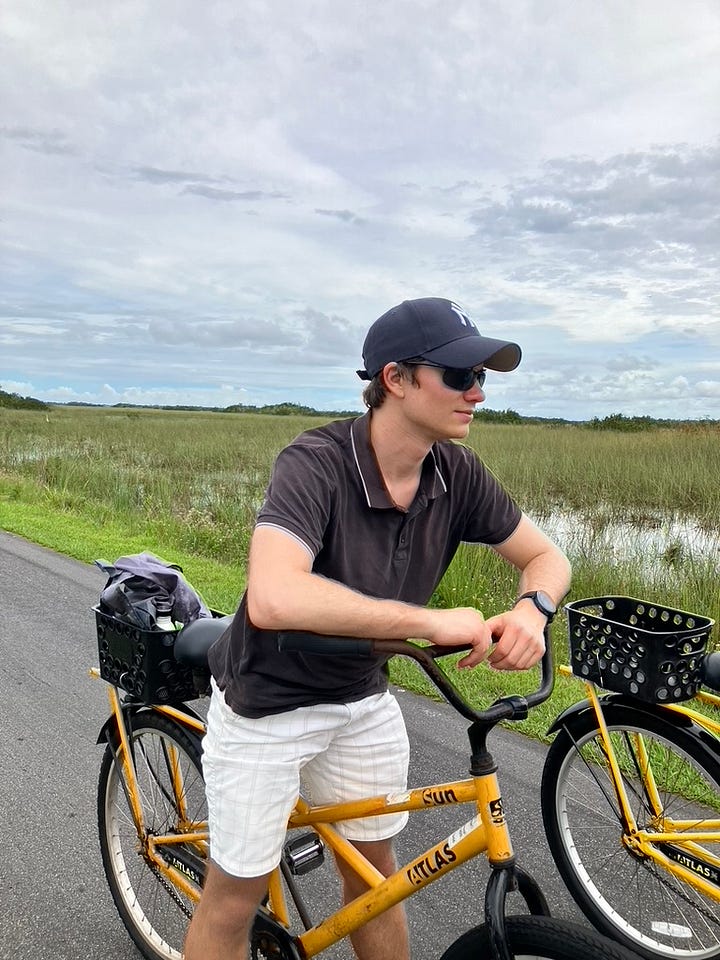Heat here sinks you like heavy drapery: it presses, covers, and wraps, binding limbs inert. This was a concern when planning my nephew’s agenda, as day two is devoted outside in the Everglades. However, following the storm of the last three days which gratefully lingered as long as possible, the clouds continue to form and all elements suggest the optimal weather for a summer bike ride in Everglades National Park.
Three entry points grant access into the park. On the west coast, the Gulf Coast Visitor Center is a small mobile unit hidden down beyond the bait shops and diners of Everglades City. Its function is to give boats, kayaks, and canoes water access around the Thousand Islands (an archipelago off shore of mangrove and palm apple tree crops) and waterways into the park. This center offers little else besides boat ramps, kayak rentals, snacks and sunblock. The Ernest F. Coe Visitor Center on the east side is the only entrance that gives cars access to the interior of the park, a one lane road with turn offs to nature trails, Long Pine Campground, look out points, and an hour’s car drive later, to Flamingo Campground, which offers tent, RV, eco lodging cabins, houseboat rentals, as well as a little general store and plenty of fishing supplies and equipment. With minimal tree cover, Flamingo Campground affords spectacular night skies (unless the storm clouds come around and alter your plans from tent to car) and during the day offers guided boat and kayak tours through waterways and into Bear Lake to the north. People spend weeks here at a time, mooring boats and doing some serious gulf water fishing. And finally, the Shark Valley north entrance is the one I’ve not yet been to, so I was pleased to put it on the agenda for my nephew and my friend who joined us for the day. Shark Valley, an hour and a half south and east of Naples along US 41, gets its name from the Shark River and Shark Bay, farther south from here, where the bull shark and a few other species are known to gather in the fresh water. They don’t swim up through the marshy water into the brackish, though, as the scaly prehistorics do. This center offers a 14-mile paved nature trail which leaves from the visitor center and heads seven miles due south as the crow flies right into the meat of the swamp to a lookout tower and then weaves its way back north so that the entire trail loop looks like a threaded needle.
We leave the world of concrete and convenience. 20 minutes later, out of Naples, the lane narrows to one as we enter Big Cypress Preserve, protected land north of the Everglades park boundary. The natural habitats of the dwindling black bear and panther, the preserve is relatively dry except in the summer rainy season which results in more vegetation varieties of palm and pine than the national park south of us. By contrast, 1.5 million acres of Everglades Park is mainly made up of swamp and slough. Even the subtly sporadic one and two feet variation in sea level can influence a different ecosystem in its small area, and are noticeable by the way that a small group of pine or palm trees take root in the middle of the vast swamp.
We bisect the preserve driving east on US 41, miles of the untouchable flooding into our open windows. The length of the land on either side of us, extending deep into a wild world of unkempt and tangled sawgrass and crops of scraggy brush and trees, provides respite for the eyes after the landscaped lawns and constructed taming demanded for more Naples. Out here the earth reaches far. Light stretches place into flat fluid space. Calmness ensues. The wide variegated sky, heavy and thick with a pallet of indigo colored clouds, embraces and forgives you of your presumed control over movement. It’s both bracing and weightless. These bulbous puffs of character shifting and rolling and orchestrating the day help acknowledge a solitude that you realize you’ve missed, but neglected.
A scattering of cars in the lot as we arrive at Shark Valley has already claimed the few shaded spots. An empty trolley wagon sits waiting for a crowd, a few volunteers chat idly under the awnings. We walk to the bike rental window and a young park service man takes our $25 bike rental fees which are “good for the whole day.” It’s only after we pay that he commands our attention.
“Now, I need to go over the rules for you. Please listen. There is more than likely a chance that it will rain on your ride.” He pauses deliberately and with full presumption that this unwelcome and intrusive forecast will harm our experience in some way, but we both just stare at him waiting for the punch line. When nothing is returned his way, he continues: “You will get wet.” Again the pause, armed with appropriate well rehearsed explanations like it’s summer in Florida or this is not my prediction but that on any device or tv, or just look at the clouds. The possibility of getting wet is as benign a threat and as likely a possibility as the wind’s direction would shift from the south to the southeast. We wait impatiently for the other “rules” that might test our mettle out there in the wilderness. “Two: you will each need two to three bottles of water for hydration.” I do the math despite not being a math person. 14 miles? I finish a liter under the heat and sun by the end of 20. I’m wondering how this is translating to Y’s mathematical sensibilities. “We sell bottled water in the gift shop” - he points around his shoulder - “there is NO water to fill up on the path.” Pause. Wait. Dual at dawn? “Third: If you have a problem with the bike or any other, wait for the volunteer in the trolley car, who can take you back, or a ranger. Do NOT leave the bike and walk.” Pause. I wonder who these bike-riding people are who need this advice. Chances are they do not do 25 miles in a rain storm. “Finally: Stay on the path. Leave your bikes on the path when you take the boardwalk to the lookout tower. Take your belongings with you. The crows are smart and can open zippered bags.” Class is dismissed.
The shock-yellow bikes are lined up along the left side of the window of the same building. We amble towards them and inspect them with suspicion. “Gun Atlas” is written in black bold letters across the transit bar. We assess seat heights and randomly each pull one out from its pack. Made perhaps decades ago, they are heavy, clunky, rusty, and clanky, something one might find in the back of a garage underneath other tried out and failed pursuits for exercise like old bowling balls and threadbare tennis rackets. We laugh at the archaic clumsiness of the bikes and take a few for test drives. Seats adjusted, we each bring along our one water bottle from home and a trail mix bag.
Nature submission is similar to sense deprivation in that it depletes the mind of any remaining residue of sound, smell, sight that living in “civilization” has imposed on us. As we venture out, we become as silent as our Mother Nature hostess. Out here, the silence lets you divest yourself of any former auditory association; the absence of structure releases us of attachment to form and visual recognition. There is no material accoutrement to measure success, contentment, dissatisfaction, nothing that might raise or lower the barometer on one’s mood or emotion. We are within a system that has survived and evolved through changes of millions of years. And so we pedal on, each washed in our own sense cleansing.
Time and space are illusions here, and it becomes apparent that both concepts are human constructions to make sense of and mentally coordinate a current, physical placement. We are surrounded by rich, open swamps and savannas that grow riches out of silence, heat, sun, and water. What grows in silence and heat? The mind has a chance, finally, to expand and shift and shape itself just as the expansive moving universe. Space is essential. Space is here. The wide sky mimics the wide earth, splitting and sharing space; the sky shifts its clouds in form and color and mood; the earth moves its water through slowly, mixing salt and fresh; the sawgrass drinks the sloughs’ seeping freshwater; the pine and hardwood find root among the rocks and boulders left over from an ice age.
A native Floridian, my friend T spots and points out the camouflaged alligators poking their noses and bulging eyes out from the water, or resting along the muddy banks of the path. We stop during the first half of the journey so Y can take as many close encounter pictures as his heart desires. They are of all sizes, but a cute foot long baby means the hidden mother is watching you. A great white heron stands sentinel on the left side of the path, gracefully takes off inland when we approach, turns and flies ahead of us for 50 yards, where it lands again on the same side, waiting for us to catch up, scouting out the areas before we arrive. It continues in this fashion until something compels it away. Shortly afterward, other great whites guide us similarly. Large blue herons are aways stock still in the shallow water stalking and hunting; the ibis and the egrets poke and nibble as they wade through; crows conglomerate and issue their warnings and streaks of orange red plumage dart into eyesight and glide overhead, light upon cattails. We stop; the clanking ceases, and the silence enfolds us.
We arrive at the halfway point. We dismount and walk across the boardwalk through a subtropical jungle crop of trees that gets us to the lookout tower and ascend the spiral ramp. The promised crows wait, stand guard, caterwaul about our trespassing. I notice their size. “Those sure are big crows.” “Those aren’t crows,” T says, “those are vultures.” When they notice we seem unperturbed, they fly off, cawing complaints, but we now have the place to ourselves. We are the sole human survivors on Earth. For miles, no one. As far as the eye can see, no one. No guards, no trolleys, no park ranger. In all directions, silence and heat and space. The slight wind makes no effort to stir and speed things up into a thing called time. We remain up there for a while. We notice and observe turtles swimming below; they move gracefully and slowly, here since forever, tomorrow uncertain.
T spots an alligator which pauses in the middle of the only path that leads back to the bikes, and this gives the whole sole survivor feel an added Jurassic Park feel. To our relief, it swaggers on to the other side. But here we are: no human evidence, besides this pavement, this abandoned, 60s designed circular, cement lookout tower, and this broken down, hanging from one nail, dysfunctional water fountain adds an apocalyptic feel to the mix. Ironically, one barely functional water filling station (“let the water run a bit,” I warn), which the rules man must have forgotten about, or thinks must be broken by now, or knows emits primarily rust, spurts out what amounts to water, and we fill up a bottle for good measure. The two vultures hang around measuring our size and their chances. We pick up the pace back to the bikes.
Our way back offers variation on neither landscape nor landmark, and with the hidden sun whose light is suffused and spread beneath the cloud cover, disorientation takes hold. It subtracts any remaining sense of space and time. I newly understand how a relationship to physical place manifests security and stability and is tantamount to survival and existence. I turn to my mathematical partner for help. “What direction are we going in anyway? I have no idea.” He looks around like a periscope, eyes towards the horizon. “There,” he points, to a distant needle poking up from the sawgrass savannah, “there is a radio tower. That must be where we started.” Logically, we must be heading north after the tower midway point, but the curves that lead us back feel neither like a turn nor return - and essentially, that’s what it is is, this natural sense deprivation extracts all we thought we knew of direction, and the concepts of a start and an end are merely arbitrary reference points for human measurements of space and time. Here, at the bottom where land and water commingle, an estuary of salt and fresh, of old and young, of light and dark, at the delta of change, we become again.








Wonderful descriptions and a reminder what I love about where I live. I much rather contend with mountain peaks and wolves than lowlands and alligators. I thoroughly enjoyed reading your travel piece!